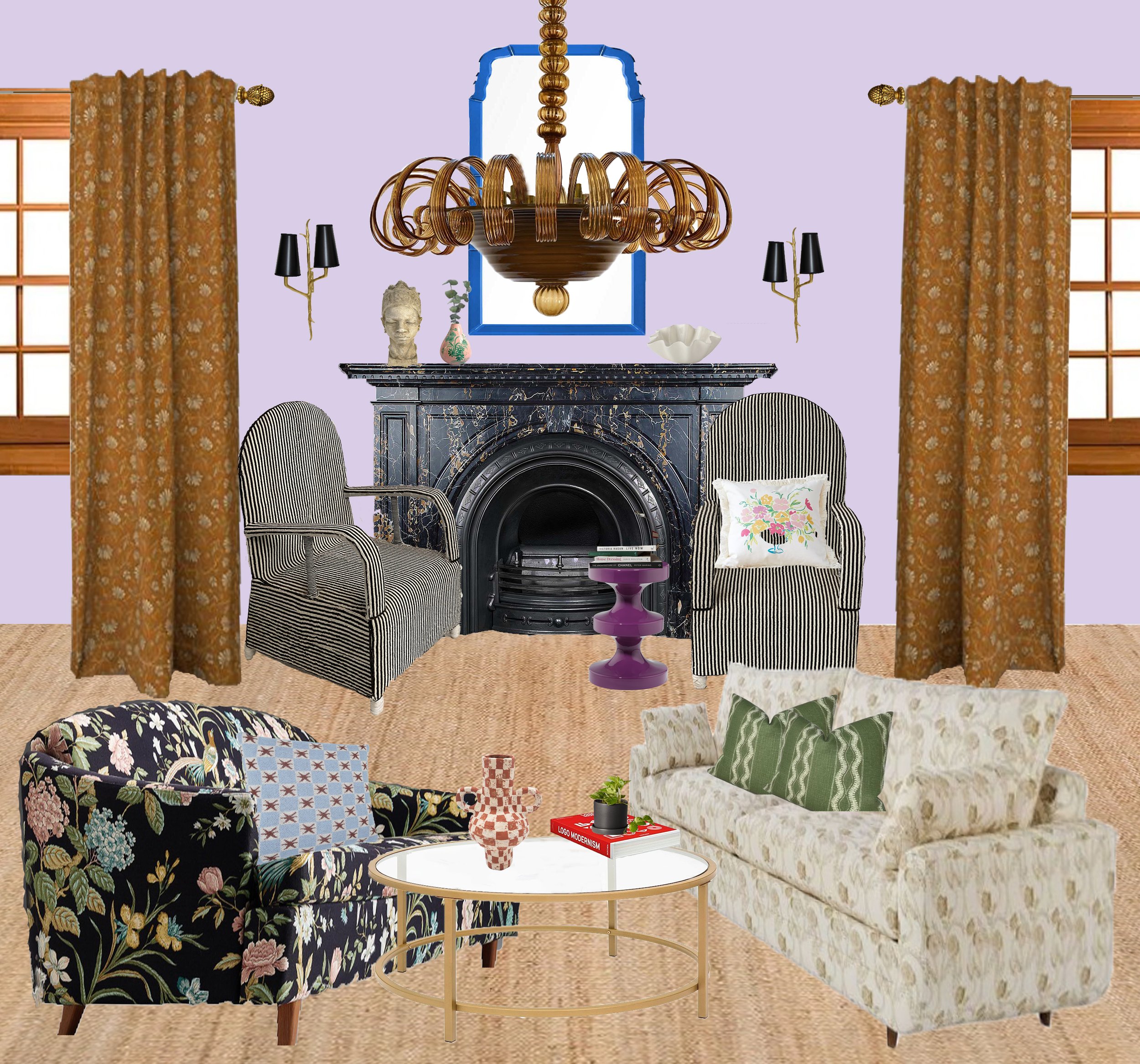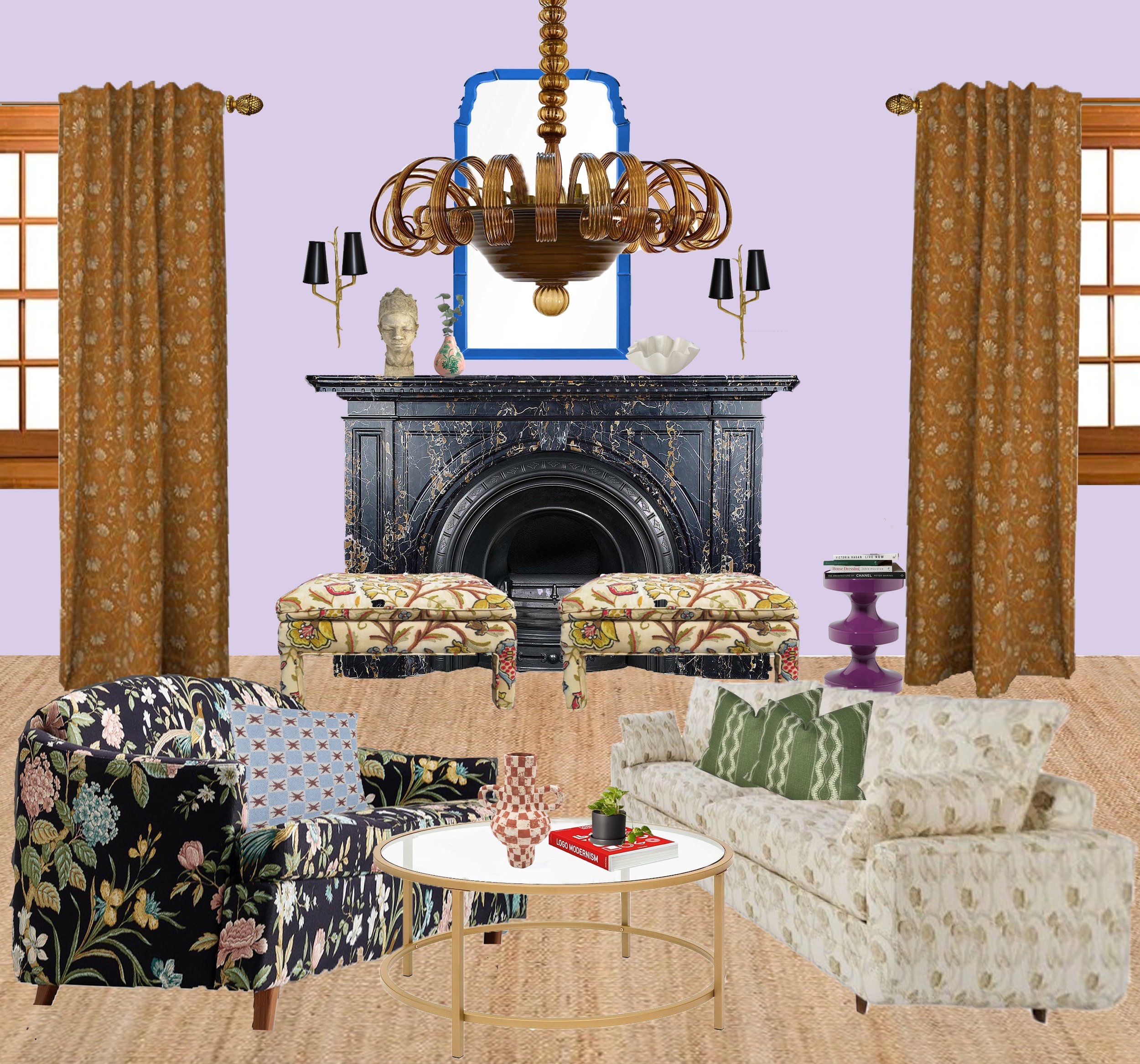Does Your Home Meet Your Social Needs?
open spaces allows people to socialize freely. face-to-face seating with movable chairs gives people varied options for socializing more intensely or more casually. Links:
chairish floral couch ; Etsy pillow; Luke edward hall zigzag pillow; Luke Edward Hall star pillow;
Glassette pillow; Amazon round coffee table; Glassette vase; Ebay Modernism book; plant; Bishop stool; Beaded chair; marble replace; Spoonflower curtains; window;African bust;Chairish sconces; Liberty London vase;Lulu and Georgia bowl; Top Modern mirror;1st Dibs chandelier; lavender paint; Revival Rugs jute rug
Interior design magazines and shows often give us clues about how our home can benefit our social life, at least ideally. We see influencers, and design connoisseurs entertaining and having friends over for weekend dinners with beautiful table settings and comfy living spaces designed to give us inspiration for our own gatherings. While it’s all so inviting, some of us may be more satisfied with our social life than others. And if we’re less than content with it, discouragement can cause us to lose hope in our ability to feel satisfied socially. Although design psychology cannot magically improve our social needs by the weekend, it can offer tools to help us better meet these needs and use the way we think about our home to do it.
Whether you live alone or with others, it’s important for your home to be able to meet your social needs. This can mean allowing opportunities for building community, carving out time for privacy, or a balance of both. When we think of the rooms in a home, we typically think of common labels like living room, family room, dining room, and bedroom; but it doesn’t necessarily mean we use the rooms that way. We may use the dining room as an office, and the living room as a place to eat meals in front of the TV. It’s important to be clear on how you use the space so you can better determine if you are using it in ways that best support what you want to achieve socially. According to design psychology, your home can be designed to support the best version of you. If you are looking to expand your social network, or increase a sense of privacy, you can create a home that acts as a catalyst for those weekend dinners or much needed alone time.
Consider how you establish relationships, build community, or make use of your private time
If you are looking to be more satisfied with your social space, consider how you establish healthy relationships, not just in your home but outside the home. That is, how do you build friendships or community? It can be hard to do when you do not have a job, a school, or any setting where you repeatedly see the same people (the ones you actually like). So it takes a little more effort; but either way creating community is about taking risks, putting yourself out there, and being friendly. You may not connect with everyone, but you can be open to what people who come into your life may give or teach you, and eventually you’ll find ones you connect with as well.
Alternatively, how do you manage your alone time? Do you enjoy your privacy and see it as a way to develop a sense of independence; or do you feel isolated, lonely, and disconnected? If you feel the latter, it may be that you do not have an adequate sense of connection with others and/or yourself. Ironically, we can be with a bunch of people and still feel lonely, yearning for a type of self-love that others cannot fill. This typically requires deeper level work to address but design psychology can offer supportive tools while you’re in the process. So with that basic framework in mind, how can you create a home that supports whatever your social needs are?
Consider open or segmented spaces
Angled seating and focal points allow for people to look away at a target to relieve anxiety. Links: 1st Dibs floral couch; One Kings Lane floral couch (see above for remaining links)
Generally speaking, a home can be divided into individual space, shared space, and public space; and we are satisfied when we have enough of each. For instance, those who are more extroverted, meaning they get their energy from being around others, may do well when a good portion of their space is public or shared. They tend to do well with open spaces as they have easier access to the people in their home. Alternatively, those who are more introverted, meaning they recharge or get their energy from their alone time, may do well with ample individual space. They tend to do well when spaces are segmented so they have a place to retreat and recharge.
Therefore, if you are looking to create more segmented spaces, consider furnishings that divide a room such as a large bookcase, a screen, or position furnishings in ways that break up the space. Or, if you’re looking to create a sense of openness or expansion in your home, consider furnishings that do not block views, and furnishings that can be moved or swivel.
Consider seating placement
Side-by-side seating options are good for people who do not know each other well. Links:
Parsons bench (see above for remaining links)
Any social setting needs seating, but the way seating is arranged can go a long way in making people feel comfortable or not so much. No matter our social needs, we all need some balance between privacy and socializing. So seating should be arranged in ways that allow people the option for both. For instance, people should have the freedom to move closer or farther away from others whether that means moving chairs or moving themselves in a large settee or sofa. It is a good idea to have flexible seating so that you can change up the arrangements to meet your specific social needs.
With flexible seating in mind, you want to make sure you have a mix of face-to-face, side-by-side, and angled seating. You’d want to position chairs face-to-face for conversations that are not stressful and purely social in nature. Place chairs side-to-side when conversations may be tense or people do not know each other well. This way they have the option to turn their head to look at each other or look away at will. Similarly, place chairs at right angles or close to it when conversations may become stressful and people have the option to look away. Additionally, when chairs are positioned in a circle facing towards one focal point, it allows people to be social but also gives the option to look away and use the focal point as an excuse to do so.
Consider seating type
How we sit in seats can promote creativity and concentration. Research shows that when people are in an expansive body posture, like in a recliner, they are less likely to be frustrated and think more creatively. This is based upon the idea that when in a more relaxed position, the excitatory system is inhibited. Thus, adding a recliner to your space can allow you or your guests the freedom to engage with others or their thoughts. But sitting upright has its benefits too. According to research, when we are sitting upright rather than slouching, we tend to have a more positive view of ourselves, and can be helpful when we are working or focused on a task.
So whatever your social needs, these recommended changes can be a first step to making significant changes that can improve or enhance a sense of community or independence.



